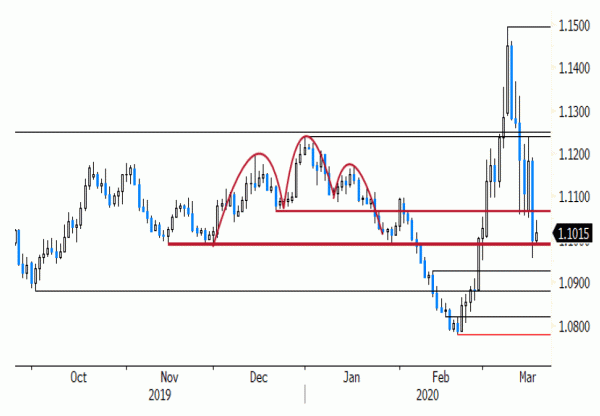- Rates: Huge US fiscal stimulus ahead, but markets still shaky
The prospect of a >$1tn US fiscal stimulus package lifted US stocks by up to 6% yesterday. US yields rose by 40 bps, but fresh Fed measures highlight that liquidity issues remain a major problem/impact as well. Risk sentiment is dwindling this morning. Governments continue adding contagion-avoiding measures, probably extending and deepening the downturn. - Currencies: Preference for USD (liquidity) persists
Yesterday, the dollar staged quite an impressive intraday rebound. Several measures of the Fed to mitigate USD liquidity stress hardly reduced the USD bid. Widening intra-EMU spreads were a negative for the euro too. For now, the dollar retains the advantage of the doubt even as few parties involved (US or other countries) profit from a strong USD.
The Sunrise Headlines
- US stocks rallied, licking their wounds from the biggest rout since 1987, as US authorities stepped up efforts. The Nasdaq outperformed (6.23%). Asian markets are struggling for direction. Australia underperforms (-6.43%).
- The WH goes big and bold and will inject $1.2 tn in the US economy to combat the coronacrisis and keep the lid on unemployment rates. The proposal is said to include cash disbursements, loans for SMEs and stabilization funds.
- The Fed has put in motion 2 emergency lending programs, the primary dealer credit facility and commercial paper funding facility, to ease credit flow to households and businesses amid growing fears over a liquidity crunch.
- The New York City Mayor warned the city is on the verge of an unprecedented “shelter-in-place” order to contain the fast-moving outbreak of the coronavirus pandemic, adding a decision will be made in the following two days.
- The EU is contemplating to kick-start joint debt issuance as a coronavirus-busting fiscal boost. German Chancellor Merkel voiced support for the idea and the proposal is also backed by French president Macron, Bloomberg reported.
- Belgian banks are drafting measures to support households and businesses hit by the coronacrisis. The measures would boost credit extension to struggling businesses and include a delay and/or spreading of debt repayments.
- Today’s economic calendar eyes meagre with only (outdated) secondary data due (housing data US, inflation figures Canada, final CPI prints EMU) which will be waved off by investors. Germany taps the bond market
Currencies: Preference For USD (Liquidity) Persists
USD (liquidity) preference persists
Hunt of USD liquidity again dominated big parts of FX yesterday and interest rate markets. The dollar staged quite an impressive rebound despite additional measures of the Fed to address shortage of USD liquidity. USD/JPY closed the session well north of 107. The prospect of a big US fiscal package maybe was a (secondary) supportive for the USD currency. In addition, the euro faced additional headwinds as intra-EMU spreads again widened substantially, putting additional pressure on EUR/USD. The pair closed the session near 1.10.
Overnight, Asian equity markets were not able to build on the technical rebound of US and European equities yesterday and even returned to outright risk off modus. Broader USD strength due to the hunt for USD liquidity this time also weighs slightly on the yuan. USD/CNY returns north of 7.00. The likes of the Aussie and the kiwi dollar are holding near recent lows despite domestic fiscal packages being put in place (expectations on QE?). The yen regains slightly ground (USD/JPY 107 area). EUR/USD also tries to rebound from yesterday’s sub-1.10 levels. Today, the multiple fiscal plans to try to manage the economic fall-out from the corona crisis and developments with respect to US liquidity remain the key drivers for global FX. The USD liquidity topic probably will prevail. After the bold Fed easing earlier this week, one could have assumed the USD dollar had lost some of its advantage. For now, USD cash remains favoured. The impact of (technical) measures to mitigate USD liquidity stress is mixed at best. In EMU, we look out for measures to fund fiscal stimulus on an EU level. From an eco-point of view this would be positive, but the impact on widening intra-EMU spreads (and thus on the euro) is unclear. Over the previous days, we assumed that some balance among the FX majors could return after the multiple Fed actions. Yesterday’s decline of EUR/USD below 1.1050/1.10 suggests ongoing USD preference. In a LT term perspective, one can raise the question whether a base might be building for global action to slow the rise of the USD (is in no one’s interest) but we’re not at that stage yet.
Yesterday, EUR/GBP entered calmer waters. The pair found a new ST equilibrium in the 0.91 area. Some euro softness maybe supported the relative performance of sterling against the euro. North of 0.91, EUR/GBP is moving into overbought territory, but for now we see little reason to expect a sustained sterling comeback.
EUR/USD: USD liquidity preference persists












